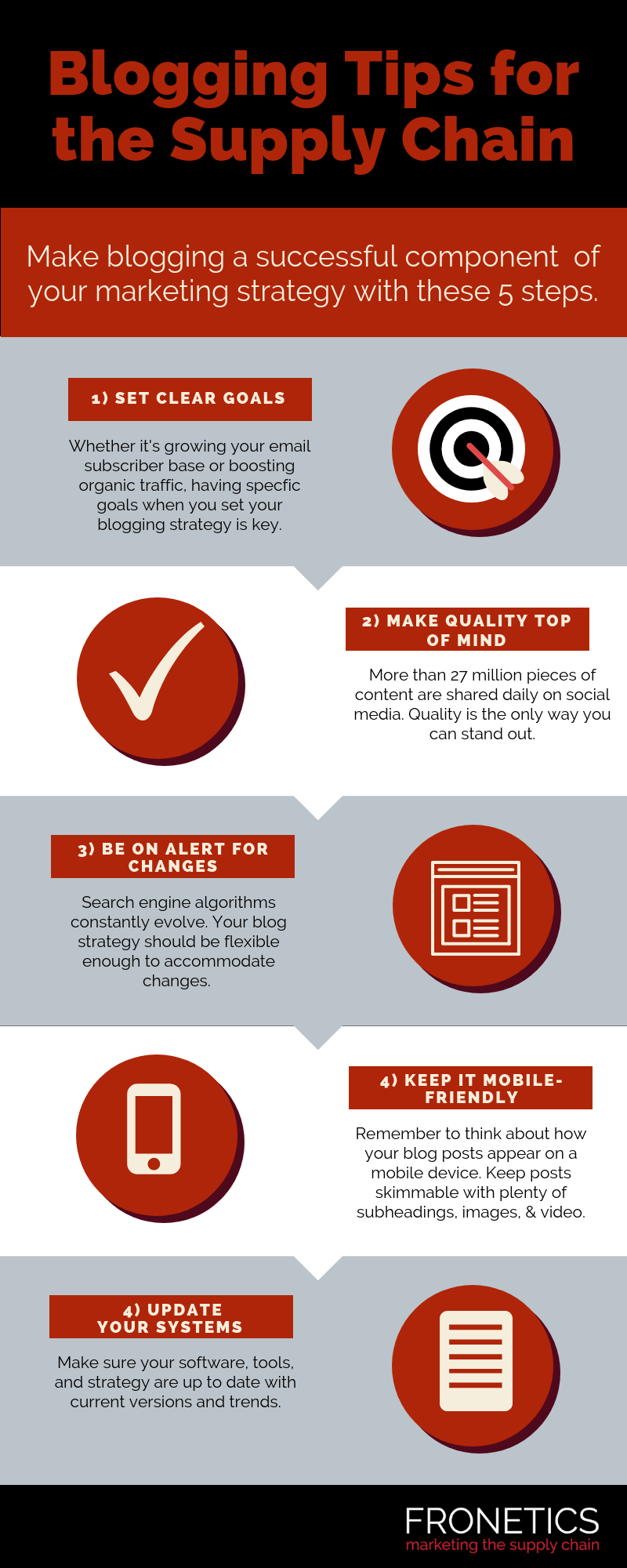
by Fronetics | Apr 1, 2014 | Blog, Content Marketing, Logistics, Marketing, Supply Chain

In the 1970s people were exposed to an average of 2,000 ads per day. Today we are exposed to more than 5,000 ads per day. The barrage of ads has resulted in buyers tuning them out. With buyers no longer paying attention to ads, businesses need to adjust how they find and engage new prospects, and how they establish and maintain long-term relationships with customers.
The solution: content. Why content is king and your business should take an oath of alliance to the kingdom.
Content is inclusive of blogs, white papers, e-books, newsletters, infographics, podcasts, webinars, and video. Creating and distributing valuable and relevant content in a strategic and consistent manner is what will drive profitable customer action.
Valuable and relevant content is not a sales pitch. It is not content that pushes your products and services. Rather, it is content that communicates valuable information to customers and prospects so that they have the knowledge to make better informed decisions. Moreover, it is content that establishes your business as a reliable source of knowledge – as the thought-leader within the industry.
How does this translate into consumer acquisition and retention? When the customer is ready to make a purchase they will reward your company with their business and with loyalty.
Skeptical? B2B companies with an active blog generate 67 percent more leads per month than those who don’t. A study by the Custom Content Council found that 72 percent of marketers think branded content is more effective than advertising in a magazine, 62 percent say it is more effective than advertising, and 69 percent say it is ‘superior’ to direct mail and PR.
Content that will move the needle for your business is valuable content. It is content that is informative, educational, interesting, and speaks to your customer’s emotions and speaks to their pain points. Furthermore, it is content that is delivered consistently over time and at the right time.
Before you start to create content for your business consider this sage advice offered by Arjun Basu: “Without strategy, content is just stuff, and the world has enough stuff.”
Research supports Basu. Companies that have a documented content strategy are more likely to consider themselves effective than companies that don’t have a strategy in place (60 percent v. 11 percent). Similarly, companies who put a person in charge of content marketing were more likely to be successful than those who did not (86 percent v. 46 percent).
How do companies put together and execute a content strategy? Eight percent of B2B marketers outsource content planning and strategy. Sixty-four percent of B2B marketers report that they outsource writing and thirty percent outsource distribution and syndication. Diving down further, 72 percent of large B2B companies (1,000 employees or more) outsource content creation and 34 percent of small B2B companies (10 to 99 employees) outsource content creation.
Content is king. By taking an oath of alliance to the kingdom, your company will attract and retain customers. Your company will realize an increase in leads, short sales cycles, and more loyal customers.
If you’d like to learn more about creating a content strategy for your business and/or about content creation , get in touch.
A version of this article also appeared on DC Velocity

by Fronetics | Apr 1, 2014 | Blog, Content Marketing, Logistics, Marketing, Supply Chain

In the 1970s people were exposed to an average of 2,000 ads per day. Today we are exposed to more than 5,000 ads per day. The barrage of ads has resulted in buyers tuning them out. With buyers no longer paying attention to ads, businesses need to adjust how they find and engage new prospects, and how they establish and maintain long-term relationships with customers.
The solution: content. Why content is king and your business should take an oath of alliance to the kingdom.
Content is inclusive of blogs, white papers, e-books, newsletters, infographics, podcasts, webinars, and video. Creating and distributing valuable and relevant content in a strategic and consistent manner is what will drive profitable customer action.
Valuable and relevant content is not a sales pitch. It is not content that pushes your products and services. Rather, it is content that communicates valuable information to customers and prospects so that they have the knowledge to make better informed decisions. Moreover, it is content that establishes your business as a reliable source of knowledge – as the thought-leader within the industry.
How does this translate into consumer acquisition and retention? When the customer is ready to make a purchase they will reward your company with their business and with loyalty.
Skeptical? B2B companies with an active blog generate 67 percent more leads per month than those who don’t. A study by the Custom Content Council found that 72 percent of marketers think branded content is more effective than advertising in a magazine, 62 percent say it is more effective than advertising, and 69 percent say it is ‘superior’ to direct mail and PR.
Content that will move the needle for your business is valuable content. It is content that is informative, educational, interesting, and speaks to your customer’s emotions and speaks to their pain points. Furthermore, it is content that is delivered consistently over time and at the right time.
Before you start to create content for your business consider this sage advice offered by Arjun Basu: “Without strategy, content is just stuff, and the world has enough stuff.”
Research supports Basu. Companies that have a documented content strategy are more likely to consider themselves effective than companies that don’t have a strategy in place (60 percent v. 11 percent). Similarly, companies who put a person in charge of content marketing were more likely to be successful than those who did not (86 percent v. 46 percent).
How do companies put together and execute a content strategy? Eight percent of B2B marketers outsource content planning and strategy. Sixty-four percent of B2B marketers report that they outsource writing and thirty percent outsource distribution and syndication. Diving down further, 72 percent of large B2B companies (1,000 employees or more) outsource content creation and 34 percent of small B2B companies (10 to 99 employees) outsource content creation.
Content is king. By taking an oath of alliance to the kingdom, your company will attract and retain customers. Your company will realize an increase in leads, short sales cycles, and more loyal customers.
If you’d like to learn more about creating a content strategy for your business and/or about content creation , get in touch.
A version of this article also appeared on DC Velocity

by Fronetics | Feb 10, 2014 | Blog, Marketing, Social Media
This article was originally published on DC Velocity.

A recent study conducted by the Corporate Executive Board’s (CEB) Marketing Leadership Council found that the average customer progresses nearly 60 percent of the way through the purchase decision-making process before engaging with a sales rep.
Where are customers looking for and finding information? Customers are turning to the internet and social media. If they are looking for your company – what are they finding? A key finding of the CEB study was: “companies that fail to ‘show up strong’ in this context are underserving potential customers and are at risk of losing mindshare and, ultimately, sales opportunities.” This is largely due to when customers tend to buy. Specifically, 80 to 90 percent of prospects who first engage with a company are not ready to buy. Forty percent of these prospects will be ready to buy within a year and 80 to 90 percent will be ready to buy within two years.
Improving your company’s visibility can be achieved by establishing a presence and by optimizing your presence. This is inclusive of launching a company blog, participating in social media, creating YouTube videos focused on your company’s products and services, and ensuring that your website is easily navigable and provides both current and potential customers with the information and services they need.
There are several tactics that can be used to increase visibility and help with measurement efforts include leveraging multiple digital platforms, regular analytics reporting, mobile optimization and content curation – a more recent trend which marketers and business owners have found as an effective method by which to establish online influence.
Both Kinaxis and SJF Material Handling Equipment have invested in becoming visible and both have seen positive results.
Kinaxis, a supply chain management company, launched an online social media campaign with the objective of doubling leads and web traffic numbers. The campaign included two online comedy series (Suitemates and The Late Late Supply Chain Show) and the launch of the company’s 21st Century Supply Chain Blog. The campaign was successful – traffic increased by 2.7 times and leads increased by 3.2 times.
SJF Material Handling Equipment the largest stocking distributor of new and used material handling equipment in the United States, has a strong presence on Facebook, Twitter, and Google+. The company reports that nearly 20 percent of their website traffic is driven by social media. Stafford Sterner, President, notes “If you’re trying to reach out to totally new markets, then you might want to do Facebook and Twitter. If you’re comfortable building that relationship with people or companies you’re close to, then it’s LinkedIn.”
Being visible is an essential part of any business strategy. Take the time to make your company visible.

by Fronetics | Feb 10, 2014 | Blog, Marketing, Social Media
This article was originally published on DC Velocity.

A recent study conducted by the Corporate Executive Board’s (CEB) Marketing Leadership Council found that the average customer progresses nearly 60 percent of the way through the purchase decision-making process before engaging with a sales rep.
Where are customers looking for and finding information? Customers are turning to the internet and social media. If they are looking for your company – what are they finding? A key finding of the CEB study was: “companies that fail to ‘show up strong’ in this context are underserving potential customers and are at risk of losing mindshare and, ultimately, sales opportunities.” This is largely due to when customers tend to buy. Specifically, 80 to 90 percent of prospects who first engage with a company are not ready to buy. Forty percent of these prospects will be ready to buy within a year and 80 to 90 percent will be ready to buy within two years.
Improving your company’s visibility can be achieved by establishing a presence and by optimizing your presence. This is inclusive of launching a company blog, participating in social media, creating YouTube videos focused on your company’s products and services, and ensuring that your website is easily navigable and provides both current and potential customers with the information and services they need.
There are several tactics that can be used to increase visibility and help with measurement efforts include leveraging multiple digital platforms, regular analytics reporting, mobile optimization and content curation – a more recent trend which marketers and business owners have found as an effective method by which to establish online influence.
Both Kinaxis and SJF Material Handling Equipment have invested in becoming visible and both have seen positive results.
Kinaxis, a supply chain management company, launched an online social media campaign with the objective of doubling leads and web traffic numbers. The campaign included two online comedy series (Suitemates and The Late Late Supply Chain Show) and the launch of the company’s 21st Century Supply Chain Blog. The campaign was successful – traffic increased by 2.7 times and leads increased by 3.2 times.
SJF Material Handling Equipment the largest stocking distributor of new and used material handling equipment in the United States, has a strong presence on Facebook, Twitter, and Google+. The company reports that nearly 20 percent of their website traffic is driven by social media. Stafford Sterner, President, notes “If you’re trying to reach out to totally new markets, then you might want to do Facebook and Twitter. If you’re comfortable building that relationship with people or companies you’re close to, then it’s LinkedIn.”
Being visible is an essential part of any business strategy. Take the time to make your company visible.

by Fronetics | Jan 17, 2019 | Blog, Content Marketing, Logistics, Marketing, Supply Chain
Blogging should be a central part of your content marketing strategy. Here are our top tips for creating and sustaining a successful supply chain blog in 2019.
Highlights:
- Blogging needs to be a central part of your content marketing strategy.
- Focus on quality over quantity.
- Make all posts mobile-friendly.
It’s the start of a new year and the perfect time to start setting goals and strategizing how to achieve them. Hopefully, blogging is a big part of your strategy for 2019 — after all, supply chain companies should make blogging a central part of their content marketing strategy for all kinds of reasons.
[bctt tweet=”At last count, users share 27 million pieces of new content on social media every single day. Twenty-seven million!” username=”Fronetics”]
Making your supply chain blog stand out from the pack isn’t always easy. That’s why we created the infographic below. Read on for our top 5 supply chain blogging tips for 2019.
5 tips for your supply chain blog

(Made with Canva)
1. Set clear goals
We know, this one sounds obvious. But you’d be surprised how often marketers overlook this seemingly simple step or settle for general, vague goals. It’s true that blogging can have all kinds of positive impacts for the supply chain, but that doesn’t mean that you should just be blogging without a clear, documented set of goals specific to your business.
Whether it’s growing your email subscriber base, boosting organic traffic, or generating more qualified leads, having specific goals in mind when you set your blogging strategy is key. For one thing, it lets you target your efforts and generate content that is focused on achieving a specific result or set of results. Furthermore, having objectives allows you to be far more effective in evaluating your results, including measuring blogging ROI, and tweak your strategy accordingly.
What are your top three goals for your supply chain blog in 2019? Let us know in the comments!
2. Make quality top of mind
Ponder this for a minute: At last count, users share 27 million pieces of new content on social media every single day. Twenty-seven million. In a world of skyrocketing quantity, quality is ever-more important. There’s a huge amount of pressure on supply chain marketers to produce a constant stream of content, but the sad truth is, if you’re not producing high-quality, substantive content, you’re wasting time and energy.
For supply chain companies in particular, it’s crucial that every piece of your content be well-researched, clearly written, focused, and trustworthy. We know that producing consistently high-quality content isn’t easy, but, trust us: if you invest the time and energy to make your content stand out, you will see the results. To get you started or keep you focused, check out our guide to creating good content for logistics and supply chain marketers.
3. Be on the alert for changes
Particularly when it comes to search engine optimization (SEO), changes happen fast these days. In August of 2017, Google updated its algorithm, continuing a set of changes we’ve been watching for a while now. Voice searches are becoming increasingly prevalent, and researchers estimate that by 2020, 50% of all searches will be voice queries.
As these changes continue to happen, it’s crucial that your strategy is lithe and flexible, ready to adapt to a quickly shifting climate. This means keeping abreast of conversations going on in the industry, following blogs you trust and respect, as well as tracking your own results, and being alert to changing trends.
4. Keep it mobile-friendly
You don’t need researchers to tell you: people are increasingly receiving and reading content on their phones. Whether it’s social media, emails, or blogs, mobile usage continues to skyrocket as devices become more and more ubiquitous and user-friendly.
What does this mean for supply chain blogs? Of course, your website needs to have a visually attractive and accessible mobile version, but it’s also helpful to think about your blog posts in terms of how they appear on a phone. Keep your posts skimmable, with plenty of subheadings to orient the reader, and absolutely include video whenever possible.
5. Make sure your systems are up to date
We keep coming back to the reality of the rate of change these days. It can be exhausting and overwhelming for marketers to keep pace. Take the opportunity of the new year to make sure all your blogging-related tools are updated and running the current software.
As you’re keeping your tools fresh, it’s also a good time to make sure your procedures are running smoothly and are at a pace with the current marketing climate. This means evaluating responsibilities and results within your team, ensuring that your editorial calendar is serving you well, and taking a look at your data collection and reporting methods.
Bonus: What not to do in 2019
These might seem obvious, but again, you’d be surprised how may marketers fall victim to these blogging “don’ts.” We figured it bore repeating.
- Don’t: attempt to post content that doesn’t reflect your business’ “comfort zone.” Stick to what you know, and do it well.
- Don’t: copy and paste text or images from other blogs. Using other content for ideas is great. Copying it verbatim is verboten.
- Don’t: post at irregular intervals. Creating a content schedule and sticking it is key to establishing a loyal following and boosting your credibility.
What goals do you have for your supply chain blog this year?
Related posts:







